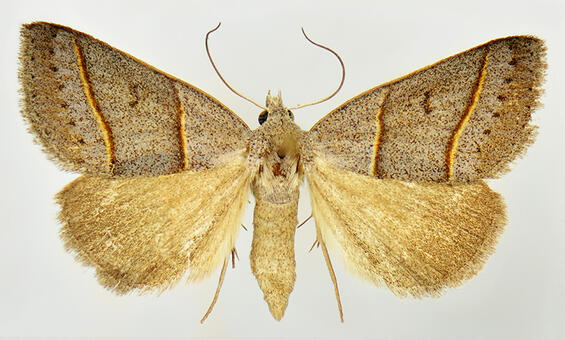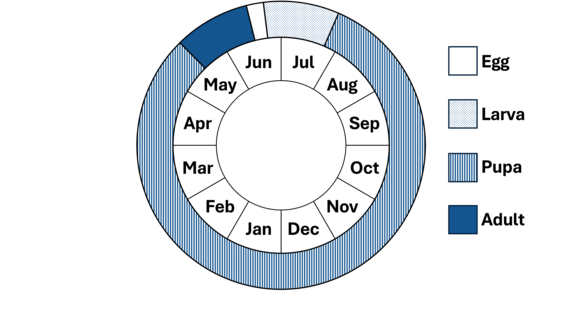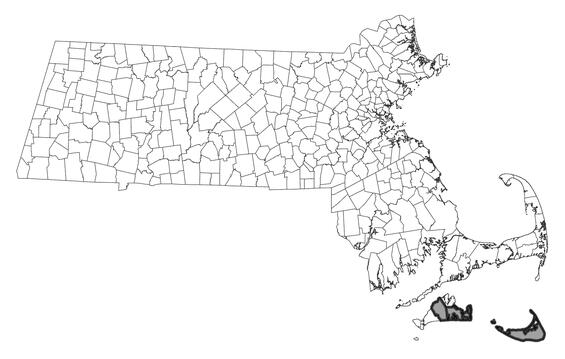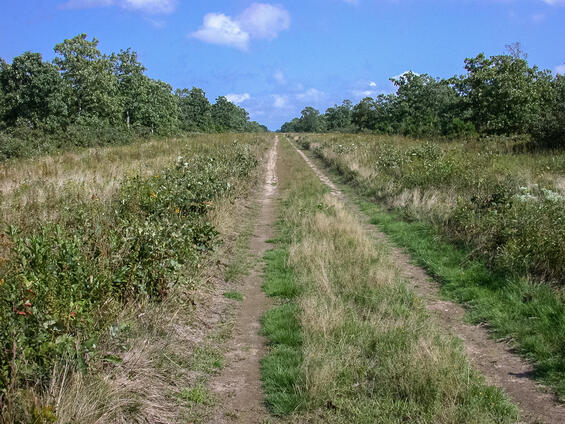- Scientific name: Ptichodis bistrigata
- Species of Greatest Conservation Need (MA State Wildlife Action Plan)
- Threatened (MA Endangered Species Act)
Description

Southern ptichodis (Ptichodis bistrigata)
The southern ptichodis (Ptichodis bistrigata) is an erebid moth with a wingspan of 27-32 mm (1.1-1.3 inches) (Covell 1984). The ground color of the forewing and hind wing vary from gray, to grayish brown, to brown. The hind wing is typically more brown than the forewing in individuals with a gray forewing (Forbes 1954). On the forewing, the subterminal area has a line of dark brown dots, which may be obscure in some individuals. The postmedial and antemedial lines are relatively straight, both consisting of dual adjacent lines of reddish-brown and yellow. The reniform spot is a relatively small, elongate patch of dark brown scales. The hind wing is typically unmarked; occasionally a faint, pale median line may be present at the inner margin. The head and thorax are concolorous with the ground color of the forewings, and the abdomen is concolorous with the hind wings. The southern ptichodis is similar to the common ptichodis (Ptichodis herbarum). However, the male common ptichodis has a black spot in the basal area of the forewing, and both sexes have an elliptical reniform spot that is relatively large and pale (Lafontaine 2015).
Life cycle and behavior

In Massachusetts, adult southern ptichodis moths fly in late May and early June. The larval host plants of this species are undocumented. Presumably the pupa overwinters.
Distribution and abundance
The range of the southern ptichodis extends from Massachusetts south to Florida, and west to Missouri and Texas (Covell 1984). In Massachusetts, this species is only known from the offshore islands of Martha’s Vineyard and Nantucket.

Distribution in Massachusetts from 2000-2025 based on records in the Natural Heritage Database.
Habitat
In Massachusetts, the southern ptichodis inhabits sandplain pitch pine-scrub oak barrens, heathlands, and grasslands.
Healthy habitats are vital for supporting native wildlife and plants. Explore habitats and learn about conservation and restoration in Massachusetts.

Shrubby grassland within sandplain pitch pine-scrub oak barrens, habitat for the southern ptichodis. Habitat managed by DCR and TNC at Manuel F. Correllus State Forest.
Threats
The southern ptichodis is threatened by habitat loss and fire suppression in its disturbance-dependent habitat, in particular sandplain pitch pine-scrub oak barrens, heathlands, and grasslands. Other potential threats include introduced generalist parasitoids, aerial insecticide spraying, non-target herbicide application, and off-road vehicles. The effect of a warming climate may not be detrimental to this species in Massachusetts; its range extends south to Florida, suggesting adaptation to warm temperatures.
Conservation
Land protection and habitat management are the primary conservation needs of this species in Massachusetts. In particular, sandplain pitch pine-scrub oak barrens, heathlands, and grasslands should be conserved, restored, and managed to maintain these habitats for this species and the entire suite of rare and threatened species dependent on such habitats.
Survey and monitoring
In Massachusetts, the southern ptichodis is known to be restricted to pitch pine-scrub oak barrens, heathlands, and grasslands on Martha’s Vineyard and Nantucket. Known populations of this species should be surveyed to document persistence at least once every 25 years; every 10 years is more desirable when practicable.
Management
Management of sandplain pitch pine-scrub oak barrens, heathlands, and grasslands benefits a suite of rare and threatened species, and habitat condition should be monitored and management adapted as needed.
Research needs
The natural history and conservation needs of the southern ptichodis are not well understood. Its life history is largely undocumented in Massachusetts, and the larval host plants used in the state are not known. The future effects of a warming climate on this species are unpredictable and should be documented.
References
Covell, C.V. 1984. A Field Guide to Moths of Eastern North America. Peterson Field Guide Series. Houghton Mifflin, Boston, Massachusetts. 496 pp.
Forbes, W.T.M. 1954. Lepidoptera of New York and Neighboring States. Part III. Memoir 329, Cornell University Agricultural Experiment Station, Ithaca, New York. 433 pp.
Lafontaine, J.D. 2015. Personal communication. April 21, 2015. Canadian National Collection of Insects, Arachnids, and Nematodes, Agriculture and Agri-Food Canada. Ottawa, Ontario, Canada.
Contact
| Date published: | March 7, 2025 |
|---|